Customer data platforms (CDPs) are becoming more and more popular and many B2B organizations are investing in packaged applications or are building their own as part of their martech stack. But what are the core capabilities of a CDP and how can a CDP specifically support a B2B organization? If you’re thinking of adding a B2B customer data platform to your marketing technology stack, here’s a guide to what CDPs can do and the specific role they can play in the B2B arena.
Why are more B2B companies looking at CDPs?
Forrester’s Landscape Report, “New Tech: B2B Customer Data Platforms,” underscores the growing significance of CDPs within B2B enterprises. This is attributed to the indisputable advantages of data consolidation and the escalating importance of data management amidst the expanding realm of artificial intelligence. B2B companies are increasingly striving to offer standout customer experiences, a goal facilitated by CDPs through their adept data management capabilities. As the report highlights, B2B CDPs excel in integrating first- and third-party data to construct unified customer profiles, thereby enhancing data quality, refining targeting efforts, and enabling the delivery of personalized experiences.
Additionally, the surge in CDP interest can be attributed to the imperative of omnichannel marketing and the persistent challenge of ensuring consistent customer interactions across various touchpoints. Marketers face the ongoing hurdle of stitching together disparate data silos to effectively target accounts and generate insightful reports. Forrester reveals that a mere 12% of B2B marketers express confidence in their data quality, with 84% citing data management as a primary weakness. Here, the customer data platform emerges as a pivotal solution, offering the capability to centralize and harmonize data for precise messaging delivery, thereby fostering alignment between sales and marketing teams.
How does a CDP work?
As per the CDP Institute, a Customer Data Platform (CDP) is prepackaged software designed to establish a persistent, unified database of customer information that can be readily accessed by other systems.
A CDP seamlessly connects, categorizes, and puts into action every piece of data pertaining to individual customers and potential leads, thereby constructing a cohesive overview. It gathers this data from various sources including sales and marketing platforms such as CRM systems and marketing automation tools, enterprise solutions like ERP systems, transaction records, customer support interactions, and even external data sources like firmographic and demographic databases, web activity logs, and advertising impressions. Utilizing identity resolution techniques, the platform intelligently links leads to corresponding accounts, a process distinct from the individual-level matching common in B2C contexts. Centralizing this wealth of data, the CDP then facilitates segmentation and empowers the execution of omnichannel personalized campaigns.
The core benefits of a CDP for B2B
Examining a CDP from a B2B perspective reveals numerous key benefits this technology offers:
1. Eliminating organizational data silos
The primary motivation behind considering CDPs is the challenge of consolidating customer and prospect data scattered across disparate platforms such as marketing automation software, data warehouses, and CRMs. By implementing a CDP, organizations enable seamless access to unified data for sales, marketing, and customer service teams. This shared access to a single, comprehensive database fosters collaboration and alignment among teams, serving as a cornerstone for synchronized sales and marketing efforts. With visibility into each other’s activities and priorities, teams can enhance their understanding of tactics and key performance indicators (KPIs), leading to more effective coordination and improved overall performance.
2. Identity resolution
Given the increasingly intricate and non-linear nature of the B2B buyer journey, identity resolution emerges as a pivotal factor. CDPs play a vital role by amalgamating all collected data into a unified B2B customer profile through precise and consistent identity resolution techniques. This involves accurately matching and merging customer data from diverse sources, including email addresses, login credentials, and IP numbers. Consequently, organizations gain access to a singular perspective of each customer, empowering various departments such as marketing, sales, and beyond to leverage shared insights and optimize their strategies accordingly.
3. Management & security
In the wake of the demise of third-party cookies in 2023 and the evolving landscape of delivering personalized experiences within a privacy-centric environment, CDPs emerge as invaluable tools. They excel in managing, collecting, and securely storing user data, all while ensuring strict compliance with data protection regulations.
4. Behavioral data collection
McKinsey & Company reports that organizations leveraging customer behavioral insights outshine their peers, achieving an 85% boost in sales growth and over 25% increase in gross margin. Behavioral data encompasses the detailed interactions of prospects and customers with your business, sourced from platforms such as social media, marketing automation systems, websites, mobile apps, CRM systems, call centers, and emails. While Customer Relationship Management (CRM) systems excel in compiling customer-facing interactions, they typically lack the capacity to gather and analyze behavioral data from diverse sources in the manner facilitated by a CDP. This capability enables businesses to construct a comprehensive understanding of customer behavior, identify churn patterns, and enhance customer retention strategies.
5. Audience building
CDPs prove highly effective in crafting segments for account-based marketing (ABM) campaigns. Enhanced segmentation translates to superior targeting and audience development. Leveraging personality traits and audience behavior, a CDP can swiftly respond to prospect intent signals on various platforms, identifying potential customers with a strong inclination to make a purchase yet have not engaged with marketing or sales teams. The capability to generate audiences by refining and analyzing data represents a valuable asset in marketing strategy.
6. Personalization
According to Salesforce, B2B customers who encounter tailored content relevant to their interests are five times more likely to engage. A CDP’s ability to segment data in myriad ways facilitates the delivery of personalized experiences. For instance, you can swiftly generate an audience from visitors to specific product pages or those who interacted with your live chat feature.
Moreover, when constructing an ABM program, the comprehensive data consolidated by a CDP proves invaluable. ABM involves targeting ideal accounts by addressing their specific pain points, nurturing relationships, and delivering targeted, customized messaging. Successful implementation of ABM necessitates substantial data to comprehend customer or prospect needs, determine the most effective communication channels, assess past deals, evaluate available information, and understand interactions with your company. A CDP excels in capturing both online and offline data, unifying it, segmenting it, and assisting in targeting prospects based on factors such as their tech stack, industry, or company size. This empowers you to develop personalized strategies tailored to each prospect.
7. Activation
Activation, a pivotal function of a CDP, involves publishing user and account level audiences to various tools within the martech stack. This includes email and digital ad platforms, enabling the orchestration of real-time, personalized messaging tailored to individual users and accounts.
8. A Single view of the customer
The comprehensive view of the customer afforded by a CDP delivers valuable insights to every department within an organization. For instance, B2B executives benefit from more accurate data to inform strategic decisions, marketers can execute more effective and profitable campaigns, and customer support agents gain the ability to resolve issues more efficiently. According to Acquia’s Customer Experience Trends Report, 93% of marketers recognize the increasing importance of gathering first-party data to understand their audience, emphasizing the significance of this capability. By aggregating first-, second-, and third-party data from diverse sources, a CDP plays a crucial role in offering a unified perspective of B2B customers. It achieves this by harmonizing, matching, and purifying data into a single source, enabling predictions regarding customer behavior, seamless integration with other marketing platforms, and ultimately facilitating better-informed marketing campaigns.
CDPs can do amazing things, but they are not for every business
When implemented effectively, CDPs offer B2B marketers a powerful solution to unify relevant data, eliminate data silos, and gain profound customer insights. With comprehensive visibility into prospect and customer data, marketers can revolutionize their marketing campaigns, refine products or offerings, and enhance every customer interaction. However, it’s important to acknowledge that a Customer Data Platform represents a significant investment in terms of finances and resources, and its complexity shouldn’t be underestimated. Many of the benefits provided by a CDP can be achieved through simpler, alternative approaches.
Before committing to a CDP, it’s prudent to carefully assess your organization’s specific needs and explore alternative solutions. Rushing into a CDP implementation without a thorough understanding of your requirements could result in using a “sledgehammer to crack a nut.” Taking the time to develop a detailed plan ensures that you select the most appropriate solution to meet your needs and maximize the return on your investment.




